The Great Zamboni
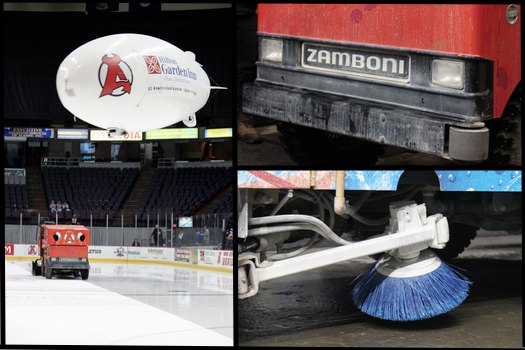
Part ice resurfacing machine, part intermission entertainment, it's no wonder everyone loves the Zamboni.
I had the chance to talk with Kevin Appler, a Zamboni driver for the Times Union Center, this week at an Albany Devils game. And I learned quite a bit: how the Zamboni works, how someone gets a job as a driver, and the fact that Zambonis don't really have brakes...
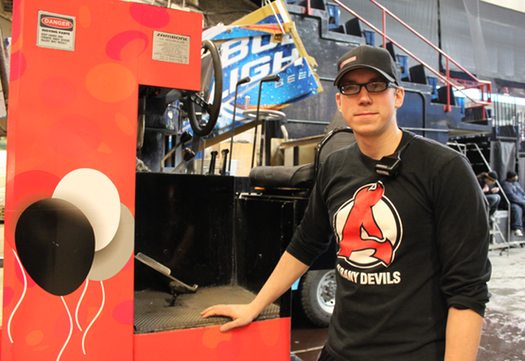
How did you get your job?
I was working at the arena and had the opportunity to learn how to do it. There's not any school where you can go to be a driver so I learned from a couple of other guys who have been doing it for awhile, and I learned the tricks of the trade.
Is it similar to driving?
A lot similar. It's just there's a huge blind spot in front; you have to get used to that and get used to turning. Also, the surface kind of changes; sometimes the ice is really rough and that makes it easier to drive; sometimes it's wet right away and you have to drive on top of that, you get used to sensing where you are on the ice and turning where you're supposed to.

How does the Zamboni work?
Basically on the back of the machine there's the conditioner; there's a big blade underneath it - you're cutting off anything that's on the ice and smoothing it out and then behind it you're laying water, so basically cutting off the top - making it nice and smooth. And, you're laying water into any of the cracks and the ice skate marks and you have to allow that to dry. It's hot water; we try to have it at 150 degrees that goes into the tanks and go onto the ice. Once that dries it creates a pretty hard layer and you do that over and over again until you have the surface that you want.
How does the brake work on the Zamboni?
It's all hydraulics -- there's actually no brake on it. There's a brake pedal, but it really doesn't do anything -- so when you take your foot off the gas, basically the power to everything goes with the gas, so you take your foot off the gas and basically the wheels stop turning.
So that's one thing you have to consider: there's no brake -- if you start going too fast and you start to hit the board or the dash there's no brake for you, so you kind of have to work that into the equation, too.
That's one thing people don't realize; there's no brakes when you're on the ice.
Have you had any close calls?
Tons of times you bump the wall; there's a roller on the front there -- it can guide you. What you want to do it be right up there against the wall, you don't want to hit it really hard -- you just want to graze the wall and it will guide you all the way around. On both machines, you really shouldn't, but the steering wheel will actually turn with the wall. So as long as you're maintaining it, it will guide you all the way around.
We've had a pretty tough winter; does this job make you better at handling ice in your car?
Maybe - it seems like I'm more aware on being able to react on ice, but they're two different kinds of things.

I know you drive during intermissions, but do you have to be out there before the games too?
Maintenance is pretty much all day long; you have to get the ice ready -- it depends on if there was a basketball game or something in the arena beforehand. There's a lot of work in the arena and you have to patch edges. It's basically maintaining it throughout the game. Before the game, and then during each intermission two Zamboni's go out and do a resurface. It takes about 12 minutes.
We're constantly taking the surface area temperature of the ice and there are coolers on the air and depending on the surface area that the ice is we have to adjust the coolers on the floor - you're trying to keep it at a certain temperature all the time.
Twelve minutes -- do you ever try to beat that time?
We've been told that we drive pretty fast and it's kind of -- you're not supposed to drive too fast. It's supposed to be a timed thing and everyone's in sequence and it makes sense so we've been working on slowing it down and making sure we do pretty good. But I haven't heard of any records -- you don't want to gun it out there you know.
Does the ice change with the weather?
Sometimes. You'll see early on in the season, or late in the season, the ice will fog up, so you'll come to a game and see that the glass is fogged up and it looks kind of weird because the temperature outside does effect that, so we have to watch that carefully.
Do you ever talk to the players about how they like their ice?
We don't really ask them, but when there's an issue we'll hear it from the coaches and it seems like when there's something right with the ice and they really like it, we'll hear it from the players.
When I first started I thought "What's the difference? Ice is ice." I've had a few players come up to me and say "The last few weeks, or the last few games, were great. You can really tell by the way I'm cutting with the skates this way or that way." I'm not really a hockey player, but it's kind of interesting that they know from the feel of the ice if it's good or not, if they like it or not.
It's nice to hear when a hockey player comes up to you and tells you you're doing a good job; that's what you're doing it for, after all.
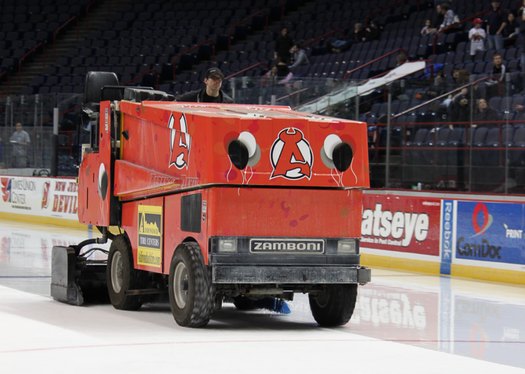
Do people get to ride on the Zamboni?
This red one here has a seat on the side; it's a birthday package for the team where you get a child -- or some adults go on there -- they have seats on the ice and then they get to ride the zamboni during the intermission. Kids have a lot of fun out there.
Do you get a lot of cheers when you get out there?
Yeah, I've never seen it where the people behind the glass don't like seeing the Zamboni. I think because it's something you don't see everyday so when you come to a game, during the intermission, that's almost something you want to see, too.
Little kids are always cheering and I drive the red one with the birthday party child on top and I ask them where are your friends seated and they say "Oh, right over here in this part," so I'll always honk when we come around. People always seem to enjoy it.
What's the craziest thing you've seen when driving the Zamboni?
The thing that I'm always worried about is when they'll do the promotions on the ice; they'll have the cheerleaders out there and stuff. It's kind of interesting how much people on the ice are not aware of this giant vehicle drving on the ice. You'll almost have to lay on the horn for them to move because the one issue is that you don't want to stop when you're on there. You really can't stop, so that's one of the things that I worry about -- people not being aware.
I've heard some of the other drivers say, you know, "Back in 2002 I had this woman who was going to lift her shirt." Stuff like that. But nothing like that for me.

It seems like you like your job.
I really enjoy it. It's something I never really considered doing but now that I'm doing it, it's like one of those things where I tell my friends and they kind of get a kick out of it.
It's one of those things where there's no real class or nothing I found where you can go and learn, so it's something that you have to learn from someone else.
I enjoy when [the ice is] really dirty, like after a basketball game. And sometimes we'll have wrestling here - - where it's dirty and there are stains and we get it crystal clear and ready for a game. I like that aspect.
And obviously driving in games is fun, too.
This interview has been lightly edited.
____
Here are some other behind-the-scenes photos from last night. They include the Devil Dog about the go on the ice during intermission, the blimp getting ready to take off, and long-time official Eric Martin keeping track of the goals.
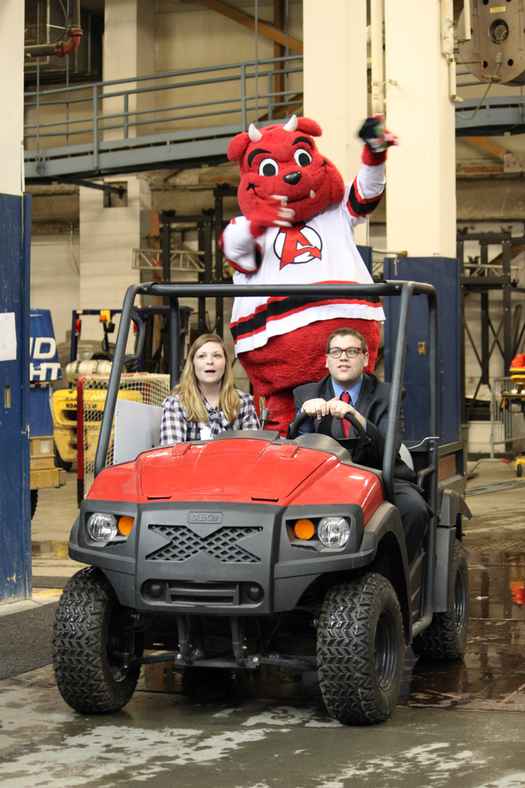
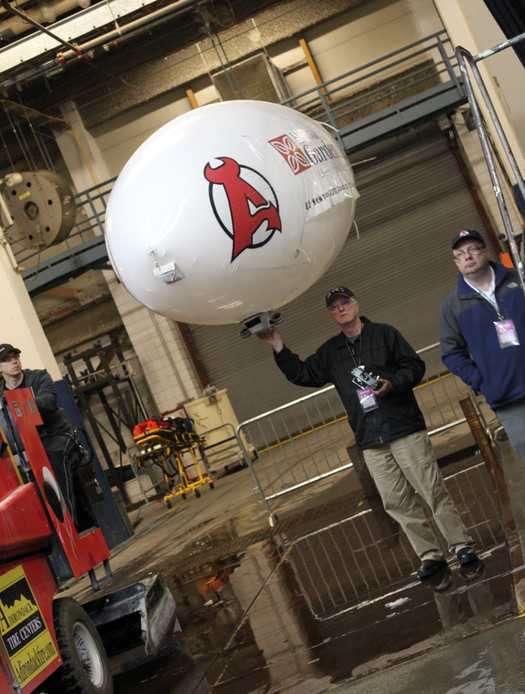

Want more Zamboni (and who doesn't)? Here's more about the history of the machine.
Hi there. Comments have been closed for this item. Still have something to say? Contact us.
Comments
I like this idea of looking at unusual local occupations. A recurring feature on AOA maybe?
... said Mr Galt on Mar 11, 2011 at 8:31 AM | link
As always, great photos accompanying article!
... said Carly on Mar 12, 2011 at 1:13 PM | link